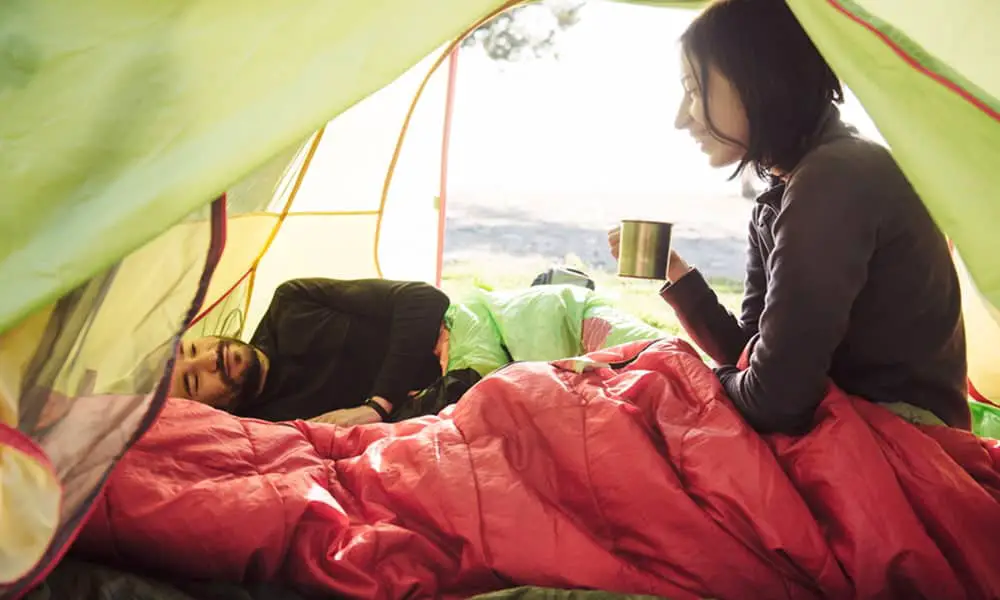Ah, the great outdoors! Camping season is fast approaching, and it’s no secret that everyone is yearning to get out of the house to be surrounded by nature after COVID lockdowns. It’s prime time to search for new camping and adventure gear.
Sleeping bags have been a necessity for campers since the very beginning. The world’s first sleeping bag was created and patented back in 1876. Since then, it’s come a long way in the materials used, shapes, sizes, and purpose.
And yet, with so much available for sleeping bags, the most underrated piece of camping gear is a sleeping bag liner. Let’s take a closer look at what a sleeping bag liner is, the benefits of using one, and what you should look for before making a purchase.
What is a Sleeping Bag Liner?
A sleeping bag liner is a lightweight piece of material that fits into a regular sleeping bag and combats all kinds of issues campers have. There are many different kinds. A fleece liner protects you from the cold, acting as an extra layer between you and cold weather. An insect shield protects you from bugs. And no matter what the liner material, they all protect you from dirt and extend the longevity of your sleeping bag.
A sleeping bag liner serves the same purpose as a sheet or duvet on a bed. Would you continuously sleep on a bare mattress with no sheets? I’m guessing the answer is no. Yet, that’s what you do when you sleep in a sleeping bag with no liner in it!
Lots of people use their sleeping bag multiple times before throwing it in the wash. This habit is not something most people think of, but it can be alarming when you consider the dirt, sweat, and insects your sleeping bag comes into contact with during each use!
When you consider a liner in this angle, it becomes clear why a camping sleeping bag liner is valuable. They are easily removable and washable, giving you the satisfaction of cleanliness during your camping expeditions. And most campers can agree that once you start using sleeping bag liners and get used to the additional layer of warmth and comfort, it’s hard going back to sleeping in a bear sleeping bag. So what exactly are the key benefits of a sleeping bag liner?

Benefits
There are multiple benefits to using a sleeping bag liner, including:
Cleanliness
Cleanliness is probably the most important reason to consider buying a sleeping bag liner. Sleeping in the same sleeping bag over and over without washing it leads to a build-up of sweat and dirt. Most people forget to throw their used sleeping bags in the wash and then use them over and over again, without giving it much thought.
Sleeping bag liners create a barrier between your body and the actual sleeping bag. It will help keep the bag clean and prevent dirt and perspiration from coming into contact with the bag. You are more likely to wash the liner after you’re done on your trip because you now look at it as a sheet or duvet. Liners are a savior when it comes to hygiene!
Adds Warmth
Sleeping bag liners add a significant amount of warmth compared to sleeping in a bare sleeping bag. It’s like having an extra blanket – these liners will provide an extra layer of padding on chilly nights. You don’t need to be into Alps mountaineering to invest in insulation for your sleeping bag. Choose a microfiber fleece sleeping bag liner for extra warmth in cold weather.
Read later – How to Clean a Sleeping Bag
Longevity of Sleeping Bag
Since sleeping bag liners can be removed easily and cleaned, it reduces the number of times you wash the actual sleeping bag, which extends the life of your bag. Campers can agree that a durable sleeping bag isn’t cheap, so maintaining its longevity is crucial.
Comfort
Sleeping bag liners will add comfort, giving you a good night’s sleep. Hikers, campers, and adventurers all need to give their bodies a nice rest when on the move. Adding a liner – especially a silk liner – to your sleeping bag will provide a cozy feel, helping you attain a peaceful, deep slumber sooner.
Multi-Use
Another perk of owning a sleeping bag liner is the multipurpose use it serves. If you travel and find yourself staying at a hostel, motel, or hotel with questionable hygiene, you can remove the liner from your sleeping bag and throw it over contaminated sheets or couch.
You can even use liners as a standalone sleeping bag, which gives you a lightweight option during warm days and nights.

Liner Materials
There are four main types of liner material: silk, cotton, fleece, and polyester blends.
Silk fabric is a popular pick because of how soft and lightweight it is. Silk liners are known to wash and dry very easily. Many choose it because of how sleek it feels against the skin when sleeping.
The cotton material liner gives great warmth and feels comfortable to sleep in. They are slightly heavier than silk and aren’t much help if it gets wet. Just like silk liners, cotton ones are easy to wash and dry.
Fleece material liner is a cheap choice but gives heavy-duty warmth. The only downfall is that it’s bulkier than other liners and takes a long time to wash and dry.
Polyester blends are a mix of other materials (such as poly-cotton blend). They are usually not as light as silk but still more packable than fleece material. It is also very easy to wash and dry.
Liner Shapes
There are two sleeping bag liner shapes: regular and mummy shape.
Regular bag liners fit inside sleeping bags that are in standard shape. This shape is also perfect to use the liner as a standalone sheet (with no sleeping bag) or while staying in motels when traveling.
Mummy shape bag liners fit inside a mummy sleeping bag that’s tapered near the bottom to give you a tighter fit for your body going down. Mummy sleeping bags and the mummy liners that go in them provide great warmth during chilly nights.
Final Verdict
Whether you’re a frequent camper or going on an impromptu hiking expedition, it’s a smart decision to buy a sleeping bag liner for your sleeping bag. It not only gives you extra insulation of warmth, but it also helps you stay hygienic, extends the life of your sleeping bag, and acts as an extra sheet when you need it.
Not all sleeping bags are the same, though. So what are some things to consider before making your purchase?
Make sure you buy the best material to suit your needs, identify the shape that fits your sleeping bag, consider the heat rating to see how warm it will keep you, and check the weight of the liner so that it’s easy for you to pack and carry.
Sleeping bag liners are a neglected piece of camping gear that will undoubtedly change the way you sleep in the great outdoors!





